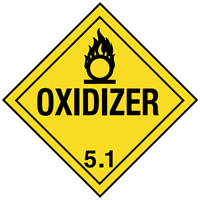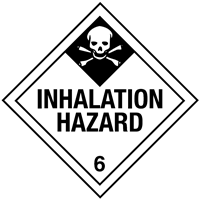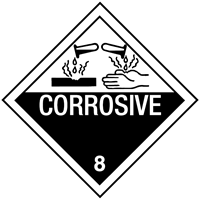Chemical Datasheet
BROMINE TRIFLUORIDE |



|
Chemical Identifiers
The
Chemical Identifier fields
include common identification numbers, the
NFPA diamond
U.S. Department of Transportation hazard labels, and a general
description of the chemical. The information in CAMEO Chemicals comes
from a variety of
data sources.
| CAS Number | UN/NA Number | DOT Hazard Label | USCG CHRIS Code |
|---|---|---|---|
|
|
||
| NIOSH Pocket Guide | International Chem Safety Card | ||
| none | none | ||
NFPA 704
| Diamond | Hazard | Value | Description | |||||||||
|---|---|---|---|---|---|---|---|---|---|---|---|---|
|
|
4 | Can be lethal. | |||||||||
|
|
0 | Will not burn under typical fire conditions. | ||||||||||
|
|
3 | Capable of detonation or explosive decomposition or explosive reaction but requires a strong initiating source or must be heated under confinement before initiation. | ||||||||||
|
|
OX |
Reacts violently or explosively with water. Possesses oxidizing properties. |
(NFPA, 2010)
General Description
A colorless to yellow, fuming liquid with a pungent odor. Solidifies at 48°F. Very toxic by inhalation and corrosive to metals and tissue. Containers exposed to prolonged heat may violently rupture and rocket.
Hazards
The
Hazard fields
include
special hazard alerts
air and water
reactions, fire hazards, health hazards, a reactivity profile, and
details about
reactive groups assignments
and
potentially incompatible absorbents.
The information in CAMEO Chemicals comes from a variety of
data sources.
Reactivity Alerts
- Strong Oxidizing Agent
- Water-Reactive
- Air-Reactive
Air & Water Reactions
Fumes in air. Reacts with water with explosive force, oxygen being evolved [Handbook of Chemistry and Physics]. HBr gas might also be produced upon reaction with water.
Based on a scenario where the chemical is spilled into an excess of water (at least 5 fold excess of water), half of the maximum theoretical yield of Hydrogen Fluoride (hydrofluoric acid) gas will be created in 1.2 minutes. Experimental details are in the following: "Development of the Table of Initial Isolation and Protective Distances for the 2008 Emergency Response Guidebook", ANL/DIS-09-2, D.F. Brown, H.M. Hartmann, W.A. Freeman, and W.D. Haney, Argonne National Laboratory, Argonne, Illinois, June 2009.
Based on a scenario where the chemical is spilled into an excess of water (at least 5 fold excess of water), half of the maximum theoretical yield of Hydrogen Fluoride (hydrofluoric acid) gas will be created in 1.2 minutes. Experimental details are in the following: "Development of the Table of Initial Isolation and Protective Distances for the 2008 Emergency Response Guidebook", ANL/DIS-09-2, D.F. Brown, H.M. Hartmann, W.A. Freeman, and W.D. Haney, Argonne National Laboratory, Argonne, Illinois, June 2009.
Fire Hazard
Behavior in Fire: Forms very toxic and irritating fumes. (USCG, 1999)
Health Hazard
Inhalation causes severe irritation of upper respiratory system. Contact with liquid or vapor causes severe burns of eyes and can cause ulcers and blindness. Contact with skin causes severe burns. Ingestion causes severe burns of mucous membranes. (USCG, 1999)
Reactivity Profile
BROMINE TRIFLUORIDE is a very reactive oxidizing agent. Reacts violently on contact with water to evolve oxygen. Accelerates the burning of combustible material. Mixing with the following hydrogen-containing substances is likely to cause a fire or explosion: acetic acid, ammonia, benzene, ethanol, 2-pentanone, hydrogen, hydrogen sulfide, methane, cork, grease paper , wax. Mixing with acids, halogens, ammonium halides, metal halides, metals, nonmetals, or metal oxides at ambient or slightly above ambient temperatures has resulted in violent reactions. Specifically, reacts dangerously with nitric acid, sulfuric acid, chlorine, iodine, ammonium chloride, potassium iodide, boron powder, selenium, tellurium, aluminum powder, bismuth, cobalt powder, iron powder, arsenic, nickel powder, chromium trioxide, charcoal, red phosphorus, sulfur dioxide, magnesium oxide.
Belongs to the Following Reactive Group(s)
Potentially Incompatible Absorbents
Use caution: Liquids with this reactive group classification have been known to react with the absorbents listed below. More info about absorbents, including situations to watch out for...
- Cellulose-Based Absorbents
- Mineral-Based & Clay-Based Absorbents
- Expanded Polymeric Absorbents
- Dirt/Earth
Response Recommendations
The
Response Recommendation fields
include isolation and evacuation distances, as well as recommendations for
firefighting, non-fire response, protective clothing, and first aid. The
information in CAMEO Chemicals comes from a variety of
data sources.
Isolation and Evacuation
Excerpt from ERG Guide 144 [Oxidizers (Water-Reactive)]:
IMMEDIATE PRECAUTIONARY MEASURE: Isolate spill or leak area in all directions for at least 50 meters (150 feet) for liquids and at least 25 meters (75 feet) for solids.
SPILL: See ERG Table 1 - Initial Isolation and Protective Action Distances on the UN/NA 1746 datasheet.
FIRE: If tank, rail tank car or highway tank is involved in a fire, ISOLATE for 800 meters (1/2 mile) in all directions; also, consider initial evacuation for 800 meters (1/2 mile) in all directions. (ERG, 2024)
IMMEDIATE PRECAUTIONARY MEASURE: Isolate spill or leak area in all directions for at least 50 meters (150 feet) for liquids and at least 25 meters (75 feet) for solids.
SPILL: See ERG Table 1 - Initial Isolation and Protective Action Distances on the UN/NA 1746 datasheet.
FIRE: If tank, rail tank car or highway tank is involved in a fire, ISOLATE for 800 meters (1/2 mile) in all directions; also, consider initial evacuation for 800 meters (1/2 mile) in all directions. (ERG, 2024)
Firefighting
Excerpt from ERG Guide 144 [Oxidizers (Water-Reactive)]:
DO NOT USE WATER OR FOAM.
SMALL FIRE: Dry chemical, soda ash or lime.
LARGE FIRE: DRY sand, dry chemical, soda ash or lime or withdraw from area and let fire burn. Do not move cargo or vehicle if cargo has been exposed to heat. If it can be done safely, move undamaged containers away from the area around the fire.
FIRE INVOLVING TANKS, RAIL TANK CARS OR HIGHWAY TANKS: Fight fire from maximum distance or use unmanned master stream devices or monitor nozzles. Cool containers with flooding quantities of water until well after fire is out. Withdraw immediately in case of rising sound from venting safety devices or discoloration of tank. ALWAYS stay away from tanks in direct contact with flames. (ERG, 2024)
DO NOT USE WATER OR FOAM.
SMALL FIRE: Dry chemical, soda ash or lime.
LARGE FIRE: DRY sand, dry chemical, soda ash or lime or withdraw from area and let fire burn. Do not move cargo or vehicle if cargo has been exposed to heat. If it can be done safely, move undamaged containers away from the area around the fire.
FIRE INVOLVING TANKS, RAIL TANK CARS OR HIGHWAY TANKS: Fight fire from maximum distance or use unmanned master stream devices or monitor nozzles. Cool containers with flooding quantities of water until well after fire is out. Withdraw immediately in case of rising sound from venting safety devices or discoloration of tank. ALWAYS stay away from tanks in direct contact with flames. (ERG, 2024)
Non-Fire Response
Excerpt from ERG Guide 144 [Oxidizers (Water-Reactive)]:
ELIMINATE all ignition sources (no smoking, flares, sparks or flames) from immediate area. Do not touch damaged containers or spilled material unless wearing appropriate protective clothing. Stop leak if you can do it without risk. Use water spray to reduce vapors or divert vapor cloud drift. Avoid allowing water runoff to contact spilled material. DO NOT GET WATER on spilled substance or inside containers.
SMALL SPILL: Cover with DRY earth, DRY sand or other non-combustible material followed with plastic sheet to minimize spreading or contact with rain.
LARGE SPILL: DO NOT CLEAN-UP OR DISPOSE OF, EXCEPT UNDER SUPERVISION OF A SPECIALIST. (ERG, 2024)
ELIMINATE all ignition sources (no smoking, flares, sparks or flames) from immediate area. Do not touch damaged containers or spilled material unless wearing appropriate protective clothing. Stop leak if you can do it without risk. Use water spray to reduce vapors or divert vapor cloud drift. Avoid allowing water runoff to contact spilled material. DO NOT GET WATER on spilled substance or inside containers.
SMALL SPILL: Cover with DRY earth, DRY sand or other non-combustible material followed with plastic sheet to minimize spreading or contact with rain.
LARGE SPILL: DO NOT CLEAN-UP OR DISPOSE OF, EXCEPT UNDER SUPERVISION OF A SPECIALIST. (ERG, 2024)
Protective Clothing
Self-contained breathing apparatus; complete protective clothing; safety glasses; face shield. (USCG, 1999)
DuPont Tychem® Suit Fabrics
No information available.
First Aid
Get immediate medical attention for all exposures.
INHALATION: remove from exposure; support respiration.
EYES: irrigate with copious amounts of water for at least 15 min.
SKIN: wash with large amounts of water for at least 15 min., then rinse with sodium bicarbonate or lime solution. (USCG, 1999)
INHALATION: remove from exposure; support respiration.
EYES: irrigate with copious amounts of water for at least 15 min.
SKIN: wash with large amounts of water for at least 15 min., then rinse with sodium bicarbonate or lime solution. (USCG, 1999)
Physical Properties
The
Physical Property fields
include properties such as vapor pressure and
boiling point, as well as explosive limits and
toxic exposure thresholds
The information in CAMEO Chemicals comes from a variety of
data sources.
Note: For Vapor Density and Specific Gravity, comparing the value to 1.0 can tell you if the chemical will likely sink/rise in air or sink/float in fresh water (respectively). Short phrases have been added to those values below as an aid. However, make sure to also consider the circumstances of a release. The Vapor Density comparisons are only valid when the gas escaping is at the same temperature as the surrounding air itself. If the chemical is escaping from a container where it was pressurized or refrigerated, it may first escape and behave as a heavy gas and sink in the air (even if it has a Vapor Density value less than 1). Also, the Specific Gravity comparisons are for fresh water (density 1.0 g/mL). If your spill is in salt water (density about 1.027 g/mL), you need to adjust the point of comparison. There are some chemicals that will sink in fresh water and float in salt water.
Note: For Vapor Density and Specific Gravity, comparing the value to 1.0 can tell you if the chemical will likely sink/rise in air or sink/float in fresh water (respectively). Short phrases have been added to those values below as an aid. However, make sure to also consider the circumstances of a release. The Vapor Density comparisons are only valid when the gas escaping is at the same temperature as the surrounding air itself. If the chemical is escaping from a container where it was pressurized or refrigerated, it may first escape and behave as a heavy gas and sink in the air (even if it has a Vapor Density value less than 1). Also, the Specific Gravity comparisons are for fresh water (density 1.0 g/mL). If your spill is in salt water (density about 1.027 g/mL), you need to adjust the point of comparison. There are some chemicals that will sink in fresh water and float in salt water.
| Chemical Formula: |
|
Flash Point: data unavailable
Lower Explosive Limit (LEL): data unavailable
Upper Explosive Limit (UEL): data unavailable
Autoignition Temperature: data unavailable
Melting Point:
47.8°F
(USCG, 1999)
Vapor Pressure: data unavailable
Vapor Density (Relative to Air): data unavailable
Specific Gravity:
2.81
at 68°F
(USCG, 1999)
- Denser than water; will sink
Boiling Point:
258.4°F
at 760 mmHg
(USCG, 1999)
Molecular Weight:
136.9
(USCG, 1999)
Water Solubility: data unavailable
Ionization Energy/Potential: data unavailable
IDLH:
12 ppm
[From IDLH Table: Bromine trifluoride]
(NIOSH, 2024)
AEGLs (Acute Exposure Guideline Levels)
| Exposure Period | AEGL-1 | AEGL-2 | AEGL-3 |
|---|---|---|---|
| 10 minutes | 0.12 ppm | 8.1 ppm | 84 ppm |
| 30 minutes | 0.12 ppm | 3.5 ppm | 36 ppm |
| 60 minutes | 0.12 ppm | 2 ppm | 21 ppm |
| 4 hours | 0.12 ppm | 0.7 ppm | 7.3 ppm |
| 8 hours | 0.12 ppm | 0.41 ppm | 7.3 ppm |
(NAC/NRC, 2024)
ERPGs (Emergency Response Planning Guidelines)
No ERPG information available.PACs (Protective Action Criteria)
| Chemical | PAC-1 | PAC-2 | PAC-3 |
|---|---|---|---|
| Bromine trifluoride (7787-71-5) | 0.12 ppm | 2 ppm | 21 ppm |
(DOE, 2024)
Regulatory Information
The
Regulatory Information fields
include information from
the U.S. Environmental Protection Agency's Title III Consolidated List of
Lists,
the U.S. Cybersecurity and Infrastructure Security Agency's Chemical Facility
Anti-Terrorism Standards,
and the U.S. Occupational Safety and Health Administration's
Process Safety Management of Highly Hazardous Chemicals Standard List
(see more about these
data sources).
EPA Consolidated List of Lists
No regulatory information available.CISA Chemical Facility Anti-Terrorism Standards (CFATS)
| RELEASE | THEFT | SABOTAGE | ||||||||
|---|---|---|---|---|---|---|---|---|---|---|
| Chemical of Interest | CAS Number | Min Conc | STQ | Security Issue |
Min Conc | STQ | Security Issue |
Min Conc | STQ | Security Issue |
| Bromine trifluoride | 7787-71-5 | 6.00 % | 45 pounds | WME | ACG | APA | sabotage/ contamination | |||
- ACG = a commercial grade.
- APA = a placarded amount.
- WME = weapons of mass effect.
(CISA, 2007)
OSHA Process Safety Management (PSM) Standard List
| Chemical Name | CAS Number | Threshold Quantity (TQ) |
|---|---|---|
| Bromine Trifluoride | 7787-71-5 | 15000 pounds |
(OSHA, 2019)
Alternate Chemical Names
This section provides a listing of alternate names for this chemical,
including trade names and synonyms.
- BROMINE TRIFLUORIDE



 |
|
